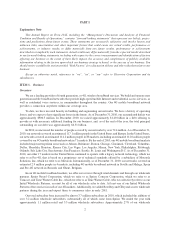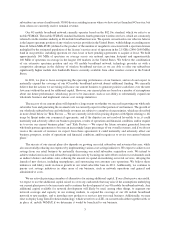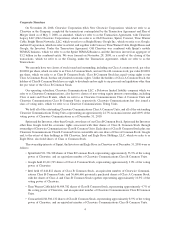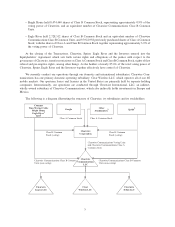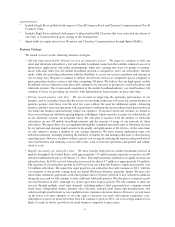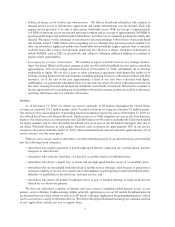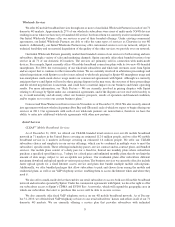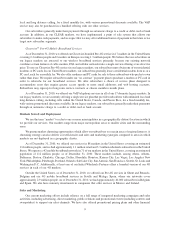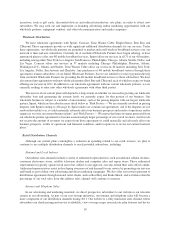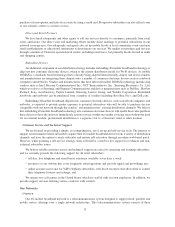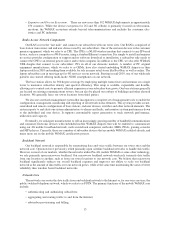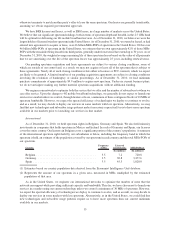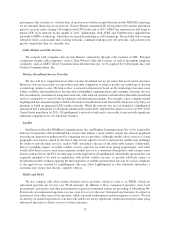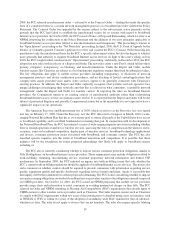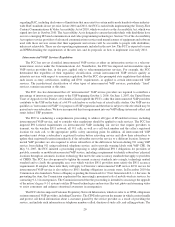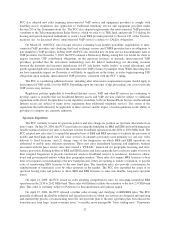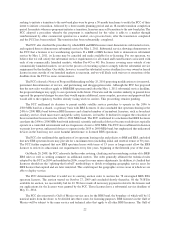Clearwire 2010 Annual Report Download - page 17
Download and view the complete annual report
Please find page 17 of the 2010 Clearwire annual report below. You can navigate through the pages in the report by either clicking on the pages listed below, or by using the keyword search tool below to find specific information within the annual report.primary elements, including the radio access network, which we refer to as RAN, the network core and the backhaul
network.
As of December 31, 2010, we operated a 4G mobile broadband network in 71 of our markets in the United
States, covering an estimated population of 112 million people. We also operate our 4G mobile broadband network
in 2 markets in Europe. We currently operate a network based on Pre-4G radio access technology in 17 of our
markets in the United States and 2 of our markets in Europe. We believe that both our Pre-4G network and our 4G
mobile broadband network have certain key advantages over 2G/3G technologies that are currently available, such
as:
• simple self-installation by subscribers and provisioning of modems;
• supports fixed, portable and mobile service offerings using a single network architecture;
• flexible and scalable IP- based architecture capable of very high capacity and efficient Quality of Service;
• a radio access technology that can service large metropolitan or small rural areas;
• ability to provide overlapping coverage from multiple sites for reliable and robust connectivity; and
• enhanced reliability and reduced latency provided by linking our towers via a microwave ring topology that
carries the majority of our backhaul traffic over licensed and unlicensed frequencies.
Additionally, we will continue to evaluate the option to deploy other technologies on our network that are
complementary or, in certain cases, alternatives to mobile WiMAX. Technologies, such as Wi-Fi, may complement
our network by allowing us to offer additional services to consumers. Additionally, we may elect to deploy
alternative technologies to mobile WiMAX, if and when they become available, on our network either together
with, or in place of, mobile WiMAX. We believe that due to our spectrum depth, common network core and inherent
flexibility in the radio access architecture, deploying other technologies on our network would be easier and at a
lower cost than building a new network.
Technology
Both our mobile WiMAX and Pre-4G networks are wireless IP-based, Ethernet platforms that are also built
around orthogonal frequency-division multiplexing, which we refer to as OFDM, and Time Division Duplex, which
we refer to as TDD, both of which allow us to address two challenges that face wireless carriers, namely non-line of
sight, which we refer to as NLOS, performance and frequency utilization. Our Pre-4G network, in both our domestic
and international markets, relies on Expedience, a proprietary technology, which supports delivery of any
IP-compatible broadband applications, including high-speed Internet access and fixed VoIP telephony services.
OFDM allows subdivision of bandwidth into multiple frequency sub-carriers so that data can be divided and
transmitted separately to ensure a higher reliability of packet data reception at the receiving end. This characteristic
of OFDM enables a 4G network to more efficiently serve subscribers in urban and suburban settings compared to
existing 3G technologies. Unlike Frequency Division Duplex, which we refer to as FDD, which requires paired
spectrum with guard bands, TDD only requires a single channel for downlink and uplink, making it more flexible
for use in various global spectrum allocations. It also ensures complete channel reciprocity for better support of
closed loop advanced antenna technologies like Multiple In Multiple Out and beamforming. Additionally, TDD
allows a service provider to maximize spectrum utilization by allocating up and down link resources appropriate to
the traffic pattern over a given market.
Relative to the other commercially available next generation wireless technologies, we believe mobile
WiMAX also has the following advantages:
•Open Standard. Mobile WiMAX technology is based on the 802.16e Institute of Electrical and Electronics
Engineers, which we refer to as IEEE, standard. It is an open standard that builds off the success of the
802.11 IEEE family of standards more commonly known as Wi-Fi.
•Time-to-Market. Mobile WiMAX had a unique head start over other 4G technologies. Commercial LTE
equipment did not start becoming widely deployed until the fourth quarter of 2010.
12


